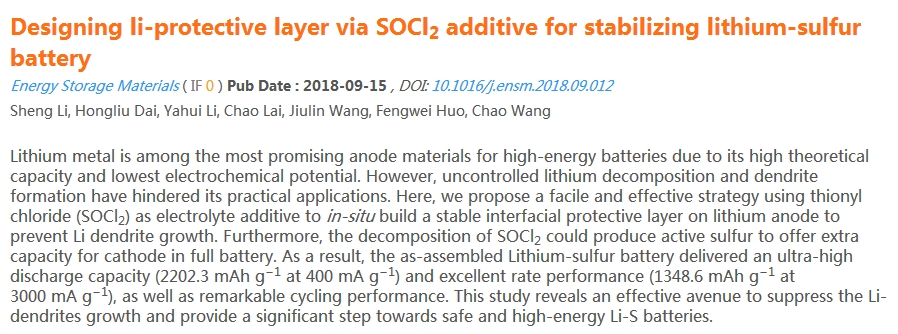Search Product
Structure Search
Search
Advantage Products
Location: Industrial Info
SOCl2 improves the performance of lithium-sulfur batteries
2018-09-30
来源:转载自第三方
2018-9-30
Recently, researchers from Nanjing University of Technology, Shanghai Jiaotong University and Jiangsu Normal University have cooperated to use thionyl chloride (SOCl2) as an electrolyte additive to stabilize the interface of lithium metal anodes and improve the long-term cycle performance of lithium-sulfur batteries. The research was published in the internationally renowned journal Energy Storage Materials in an article entitled "Desiging Li-protective layer via SOCl2 additive for stabilizing lithium-sulfur battery".

The lithium metal negative electrode has a specific capacity of 3,860 mAh/g and is considered to be the most promising anode material for lithium batteries. However, despite decades of research, commercialization is still limited by the problems of short cycle life, low utilization efficiency, and poor safety due to dendrite growth and volume expansion. The new-generation battery lithium-sulfur battery uses lithium metal as the negative electrode and sulfur as the positive electrode, which is expected to have a high positive electrode capacity (theoretical value is 1,675 mAh/g). However, the problem is that lithium sulfide, an intermediate product of the discharge reaction, is easily dissolved in the electrolyte. As the charge and discharge cycle progresses, the dissolved polysulfide ions repeatedly initiate a redox reaction between the positive electrode and the negative electrode, thereby causing the degradation of battery capacity.
In order to solve the above problems, in recent years, researchers have tried various strategies such as solid electrolyte, electrolyte component optimization, and artificial SEI membrane construction. Among them, the optimization of the electrolyte composition is popular because of its simple operation, almost no influence on energy density, and low cost. In general, the role of the film forming electrolyte additive is to assist in the creation of a strong SEI film to protect the electrode. Commonly used representative film-forming additives are ethylene carbonate, N,N-dimethyltrifluoroacetamide, 1,2-trifluoroacetylethane in propylene carbonate, and vinylene carbonate and SO2 in dimethyl carbonate system. However, in the electrochemical reaction process, the additive is also continuously consumed, and the task of finding an additive that is beneficial to the long-term electrochemical cycle is very urgent.
In this paper, the author adds 2% by volume of SOCl2 to the traditional carbonate electrolyte. When lithium is in contact with thionyl chloride, a chemical reaction occurs, resulting in inorganic substances such as LiCl, S and a small amount of SO2. LiCl not only has a certain ion conductance, it can regulate the uniform diffusion of lithium ion current at the interface of the negative electrode, form a uniform and dense artificial SEI film as a physical barrier to directly contact the electrolyte with the lithium negative electrode; S elemental substance is dissolved in the electrolyte (The electrolyte turns from transparent to yellow), and it will gradually provide additional capacity for diffusion to the positive electrode during discharge. The thus assembled Li-S battery has a discharge specific capacity of up to 2202.3 mAh/g at a current density of 400 mA/g, and the portion exceeding the theoretical capacity comes from the decomposition compensation of the additive.
The research not only solves the stability problem of the interface of the metal lithium anode, but also further introduces the thionyl chloride additive into the lithium-sulfur secondary battery, which improves the electrochemical performance of the lithium-sulfur battery, and provides new idea for the subsequent development.
Related links: propylene carbonate (PC)
Edited by Suzhou Yacoo Science Co., Ltd.
如果涉及转载授权,请联系我们。












